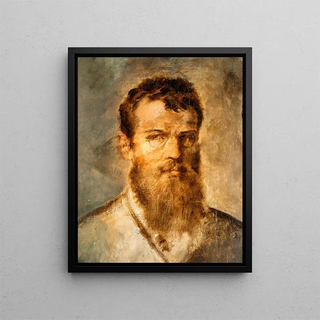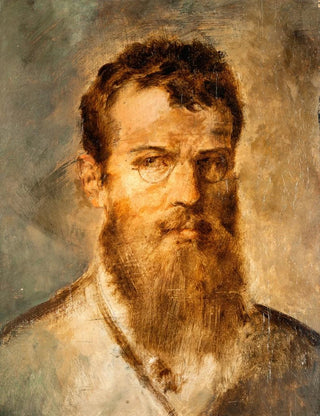Art print | Self-portrait - Franz von Lenbach


View from behind

Frame (optional)
In the fascinating universe of art, few works manage to capture the very essence of the artist like Franz von Lenbach's self-portrait. This canvas, imbued with psychological depth and technical mastery, invites us to delve into the artist's soul, revealing not only his face but also his thoughts and emotions. Through this masterpiece, Lenbach does not merely depict himself; he offers us a reflection of his era, an open window into the aspirations and struggles of the 19th-century man. The art print of this iconic work allows for rediscovering the richness of its expression and appreciating the virtuosity of its creator.
Style and uniqueness of the work
Lenbach's self-portrait stands out with its vibrant color palette and dramatic lighting, characteristic of the artist's style. The shades of blue and brown, intertwined with touches of light, give his face an almost sculptural dimension. Lenbach skillfully plays with shadows, creating a play of light that reveals the texture of his skin and the depth of his gaze. This portrait is not limited to a simple representation; it is an exploration of identity, a dialogue between the artist and the viewer. Lenbach's confident posture, his penetrating gaze, and his intense concentration testify to his determination and passion for art. Every brushstroke seems charged with intention, a reflection on the artist's place in society and his role as a creator.
The artist and his influence
Franz von Lenbach, an emblematic figure of the German artistic movement, knew how to mark his era with his exceptional talent and unique approach to portraiture. Trained at the Academy of Fine Arts in Munich, he was influenced by the great masters of painting, while developing a personal style that is uniquely his own. Lenbach managed to capture not only the appearance of his subjects but also their essence, their character. His work influenced many contemporary artists and paved the way for a new approach to portraiture, where emotion and psychology take precedence over mere physical representation. Through his portraits of famous personalities

Matte finish

View from behind

Frame (optional)
In the fascinating universe of art, few works manage to capture the very essence of the artist like Franz von Lenbach's self-portrait. This canvas, imbued with psychological depth and technical mastery, invites us to delve into the artist's soul, revealing not only his face but also his thoughts and emotions. Through this masterpiece, Lenbach does not merely depict himself; he offers us a reflection of his era, an open window into the aspirations and struggles of the 19th-century man. The art print of this iconic work allows for rediscovering the richness of its expression and appreciating the virtuosity of its creator.
Style and uniqueness of the work
Lenbach's self-portrait stands out with its vibrant color palette and dramatic lighting, characteristic of the artist's style. The shades of blue and brown, intertwined with touches of light, give his face an almost sculptural dimension. Lenbach skillfully plays with shadows, creating a play of light that reveals the texture of his skin and the depth of his gaze. This portrait is not limited to a simple representation; it is an exploration of identity, a dialogue between the artist and the viewer. Lenbach's confident posture, his penetrating gaze, and his intense concentration testify to his determination and passion for art. Every brushstroke seems charged with intention, a reflection on the artist's place in society and his role as a creator.
The artist and his influence
Franz von Lenbach, an emblematic figure of the German artistic movement, knew how to mark his era with his exceptional talent and unique approach to portraiture. Trained at the Academy of Fine Arts in Munich, he was influenced by the great masters of painting, while developing a personal style that is uniquely his own. Lenbach managed to capture not only the appearance of his subjects but also their essence, their character. His work influenced many contemporary artists and paved the way for a new approach to portraiture, where emotion and psychology take precedence over mere physical representation. Through his portraits of famous personalities






